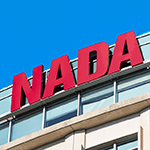NADA Issues Second Quarter 2022 U.S. Auto Sales and Economic Analysis
TYSONS, Va. (July 8, 2022)—Today, the National Automobile Dealers Association (NADA) issued its analysis of U.S. auto sales and the economy for the second quarter of 2022.
“As has been the case in recent months and for the last year, new-light vehicle sales continue to be limited by inventory constraints across all OEMs,” said Patrick Manzi, NADA chief economist. “At the end of the second quarter, inventory levels were up by 8.3% compared to the start of the year but remain down 12.3% year-over-year.”
The second quarter of 2022 closed with new-light vehicle sales in June totaling a SAAR of 13.0 million units, a decline of 16% compared to June 2021; however, sales were up by 2.3% compared to May 2022’s SAAR of 12.7 million units. For the second quarter, new light-vehicle sales averaged a SAAR of 13.4 million units, down 5% from 14.1 million units in the first quarter of 2022.
Alternative-fuel vehicles continued to gain market share with consumers showing increased interest in electrified vehicles, including battery electric, hybrid and plug-in hybrid vehicles, given increasingly high fuel prices. Through the second quarter, battery electric vehicles (BEVs) accounted for 4.8% of sales, hybrid vehicles accounted for 5.9% and plug-in hybrid vehicles (PHEV) accounted for 1.4% of sales. Year to date, franchised dealerships sold more than 106,000 BEVs, 32.5% of all BEVs sold. This number is anticipated to continue rising as more BEVs from traditional auto manufacturers hit dealership showrooms.
In June 2022, the average transaction price for a new light-vehicle was the highest on record at $45,844, an increase of 14.5% compared to June of 2021, according to J.D. Power. Prices have continued to rise as OEMs have prioritized the production of higher trim level, more expensive models while simultaneously reducing incentive spending. According to J.D. Power, average incentive spending per new vehicle was $930 at the end of June 2022, a decrease of 59.4% year-over-year and the second consecutive month below $1,000.
Monthly payments, in line with transaction prices, have also increased and reached $698 in June 2022, an increase of $79 or 12.8% versus June 2021, J.D. Power says. According to Edmunds, 12.7% of consumers who financed a new vehicle in June 2022 had a monthly payment of $1,000 or more, the highest on record and up from 7.3% in June 2021.
“With fewer new cars available, many consumers have turned to the used vehicle market and that increased demand has helped sustain these high used vehicle prices that we’ve seen over the past year,” added Manzi. “Used vehicles values have fallen from recent highs, but not by much, and in recent weeks we have seen an uptick in values at auctions for smaller, more fuel-efficient vehicles given the high gas prices we’re seeing nationwide.”
At the macro level, inflation continues to impact the U.S. economy with prices surging for many consumer essentials such as food, energy and housing.
“Despite solid wage and jobs growth, many Americans feel that this inflationary environment is leading to reductions in their standard of living, which is reflected in recent consumer confidence surveys,” noted Manzi.
The University of Michigan’s Index of Consumer Sentiment recorded is lowest level on record at the end of June 2022. A recent report from Moody’s Analytics estimates that the average American household is spending an extra $460 each month because of inflation.
In an effort to rein in inflation, the Federal Reserve increased interest rates twice during the second quarter of 2022 bringing the target range of the Fed Funds Rate to 1.5% to 1.75%. Given such persistent and high inflation, we expect that the Fed will increase rates by 75 basis points at their July meeting and that the Fed Funds Rate at the end of 2022 will be in the range of 3% to 3.25%. Following the increases in the Fed Funds Rate, the average interest rate on a new vehicle finance contract reached 5% in June 2022, the highest since the start of the pandemic.
“We should see average interest rates for new and used vehicle finance contracts at or above their pre-pandemic levels by the end of the summer when factoring in the Fed’s trajectory on interest rates,” said Manzi. “As rates climb higher, interest rates will shift from a tailwind for vehicle affordability to a headwind.”
Given the persistent production disruptions during the first half of the year and the resulting diminished sales performance, NADA has reduced its 2022 new light-vehicle sales forecast to 14.2 million units, down from our initial estimate of 15.4 million units at the start of the year.
“Despite this forecast reduction, we expect that 2022 will be another very solid year for America’s franchised dealers,” added Manzi.
Click here to read the full June 2022 NADA Market Beat report.
###
About NADA
The National Automobile Dealers Association (NADA), founded in 1917, represents more than 16,000 light-vehicle and commercial-truck dealerships with 32,500 domestic and international franchises. New-vehicle franchised dealers are directly responsible for more than one million U.S. jobs.
Media Contacts

Jared Allen

